This week i’m interviewing Oliver Walker on the blog. I discovered his work a few days (or was it weeks??) ago while visiting Time & Motion: Redefining Working Life, a FACT Liverpool exhibition exploring how the working day has evolved from the time of the industrial age to our current service and knowledge economy.
Walker’s One Pound installation at FACT lined up 6 videos. Each of them ‘lasts as long as it takes the person depicted to earn £1, varying in length from several hours for the some of the lowest paid agricultural workers in the world, down to several seconds for well paid workers in finance, with one film little over a second long.’ The idea was ultra simple and the result is striking for the way it exposes vast disparities in working patterns.
When i was there only one screen was on but that was enough to make me want to know more about the piece and about the work of an artist who uses live art, interventions and new media to investigate social and political systems; and to find his position in and to these larger systems.
Some of his projects involved outsourcing the production of a written constitution for the UK to China and having 1,000 dolls voice it, using the price of an African financial index to control lighting in a Berlin art center, testing certain hypotheses about social behaviour in a dinner party. And building an outdoors spiral staircase for cats.
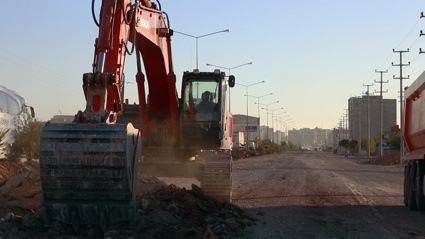 Oliver Walker, One Pound (12 minutes)
Oliver Walker, One Pound (12 minutes)
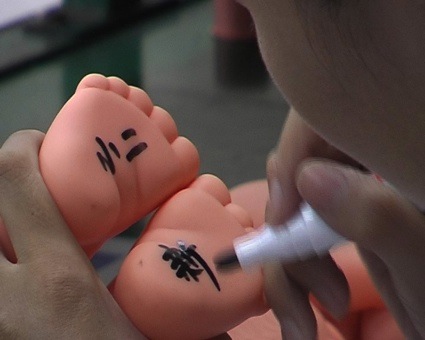 Oliver Walker, Mr Democracy. Democracy Production (video still, via)
Oliver Walker, Mr Democracy. Democracy Production (video still, via)
Here how my online conversation with the artist went…
Hi Oliver! Let’s start with One Pound, the video installation which i discovered a few days ago in the exhibition Time & Motion in Liverpool. I’ve been quite unlucky in my visit because when I entered the room there was only one screen on with a man working in a field. On the other hand seeing him work all alone on his screen made the impact of the artwork even more powerful for me. Who were these 6 workers you contacted? What were their job?
For the readers who haven’t seen the work, I feel I should describe it a little more. The six films are displayed on six adjacent screens, with all six starting simultaneously and not re-starting until all six have played through. This means that the shortest, one second long, plays just once every one hour and seventeen minutes (the duration of the longest). The films have a ‘hours:minutes:seconds’ timecode burnt into the bottom right corner, which pauses when the films end.
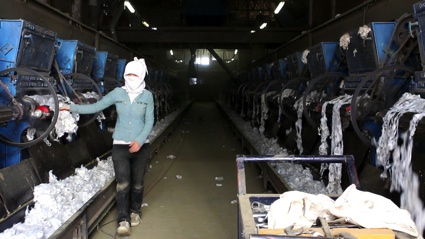 Oliver Walker, One Pound, 2013 (35 minutes)
Oliver Walker, One Pound, 2013 (35 minutes)
To the side of the 6 screens were six label-sized photographic stills from the videos, there to give the viewer a visual idea of who wasn’t currently visible. I chose not, however, to include too much contextual information about the protagonists in the gallery itself, hopefully leaving some space for viewers to project their ideas and experiences about who and where they might be. Having said this, the five you missed were; someone working in a cotton processing plant (35 minutes), someone driving a digger constructing a new road (12 minutes), a carpenter (4 minutes), digital media worker (1 minute), and a CEO (1 second).
The original idea for the piece was to show it in a space in which people repeatedly spend time, such as a busy commuter platform, factory canteen or large office foyer, but this wasn’t possible on this occasion. The idea would be that viewers would build up a kind of cumulative viewing of all six films. With a few minutes a day over three months, for example, a viewer would see all six films in their entirety, despite the shortest only running for one second every one hour twenty minutes.
The stills mounted adjacent to the video screens function as kind of visual labels. Between these still images and the timecode built into the videos, viewers could understand the relationship proposed by the piece between between time, money and occupation. I almost always make work that needs some basic explanation (usually text), but I’m happy if it then becomes somehow autonomous (whilst not perplexing) beyond this.
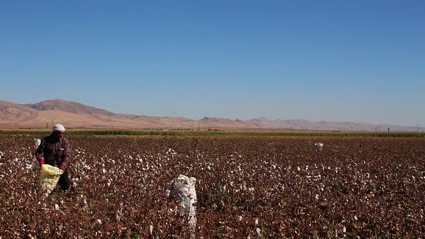 Oliver Walker, One Pound, 2013 (1 hour 17 minutes)
Oliver Walker, One Pound, 2013 (1 hour 17 minutes)
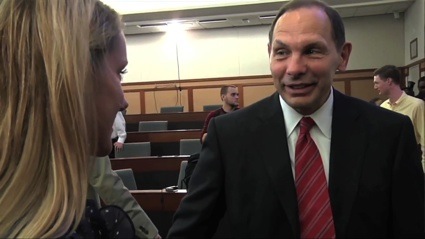 Oliver Walker, One Pound (1 second)
Oliver Walker, One Pound (1 second)
And how did you select who or which type of work would appear in your videos?
Essentially the people and jobs featured can be from any working environment, but certain criteria did develop along the way. These criteria may be quite self explanatory; they tend to be people who can be isolated for filming (though not exclusively), so those who work alone; and who I can approach fairly directly in their place of work; and people whose work you can understand visually.
After some time working on the project I also developed a kind of rationale to link all the protagonists. Although it is not explicitly mentioned in the exhibition text, this rationale is that everyone filmed is, however indirectly, related to my morning shower. So there are people working with cotton (to produce a towel), infrastructure (to get that towel to me), carpentry (to produce a bathroom door), advertising (funded by advertising on shower products), and the CEO of a company that makes shampoo. I am also interested in developing the project and filming further protagonists, perhaps for further exhibition contexts, or just to develop the work. I often considered featuring just one industry, such as coffee, and this too would have been very quotidian. However, I felt this would have then been a study of that particular industry, and it should be broader than this. The shower is something quotidian (in highly industrialised parts of the world), but still fairly unbranded, and less loaded than the tea or coffee industries which have their own histories.
Incidentally, I filmed myself first, but discarded this.
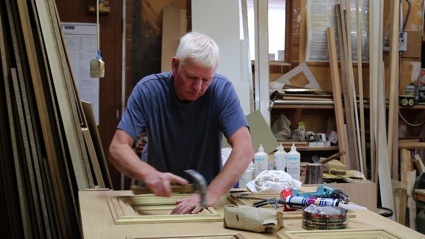 Oliver Walker, One Pound (4 minutes)
Oliver Walker, One Pound (4 minutes)
Which kind of ideas, conclusions and reflections about the labour market did working on this project trigger?
Although I started with the basic premise of wage inequality across the world, the project is not intended simply as a didactic essay on wage inequality. Clearly, it may offer reflection on these staggering inequalities, and this political position is ultimately not left ambiguous. However, the relationship between labour and money is transformed into a more subjective medium – time. Periods of time are not as easily compared with one another as pieces of graphical information, for instance. With video, the timescale is embedded into the medium (unlike photography, graphics or text).
Another way it should offer complexity is by inviting some ‘cross’ comparisons of inequality – between farm workers and factory workers both in the global south for example, or between well paid creative economy workers and astronomically wealthy bankers. This picks up on something I had observed over several years. On the occasions I had spent time in poorer countries (such as Paraguay), I noticed that there was a tendency to over simplify both the wealth and poverty that existed in the global south and north (though perhaps I’m doing this by using the word ‘both’, but bear with me).
There can be tendency to think the streets are paved with gold in Western Europe (for example), and not understand the poverty that exists in the global north too. At the same time, to try to explain for example the extent to which the National Health Service in the UK offers all people in the country, regardless of income, world class quality healthcare free at the point of delivery, might well be unimaginable to many (although this isn’t confined to those from poorer countries). Likewise, growing up in western Europe, I think it was difficult to comprehend both the extreme poverty existent in developing countries (hence the TV programmes and campaigns to help us), and the extent to which everything, such infrastructure, education and government, does function much as it does in western Europe. Perhaps this is just me, because I grew up when Live Aid was rocking, though I think little has changed.
I think it’s a constant struggle to understand this complexity – to keep talking about the extreme inequality and poverty that exists in poorer countries, without stereotyping. My work, not for the first time, sails close to the wind when it comes to stereotypes. I have used very simple (perhaps over simple, certainly flawed) measures, but the breadth of examples of labour, and the choice of images, should leave some space for these issues.
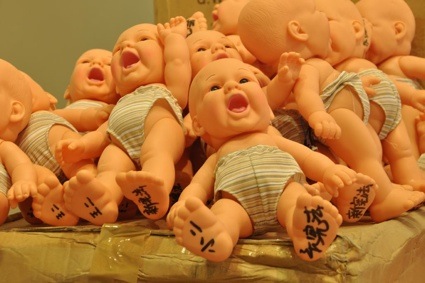 Oliver Walker, Mr Democracy
Oliver Walker, Mr Democracy
I had no idea that the UK is one of only three countries in the world without a written constitution. So what was the constitution you outsourced to China for the Mr Democracy project like? Standard constitution mixing other, existing constitutions? Something entirely original? A simple writing down of the laws and principles that already govern the UK?
I actually studied this in school, and have been interested in it since then. I was interested in going to China, and started, as I not infrequently do, with some pretty simple interests – in this case lightening fast economic development and the political situation in China. Fortunately, I had this moment of realising I could turn it around, and look at the UK, which I am probably in a better position to make work about. If I get the project right, both the UK and China are criticised.
The constitution is not very revolutionary, sadly, we’re still a constitutional monarchy – no republic! The authors initially tried to define more or less how the UK is at the moment, and then did a few tweaks to it. It was originally written in Chinese, and a fourth colleague of theirs translated it in English. Her language register and vocabulary were great, but occasionally she slipped with a few terms – but rightly so. So an early clause starts ‘The regime of the United Kingdom is…’, while we normally only hear the word ‘regime’ to define forms of government not currently popular or viewed as democratic by western governments (or ‘regimes’!). I invited the authors to refer to other constitutions when drafting the UK’s, and they did, and this is common practice when constitutions are written (the US was heavily influenced by the French, for example).
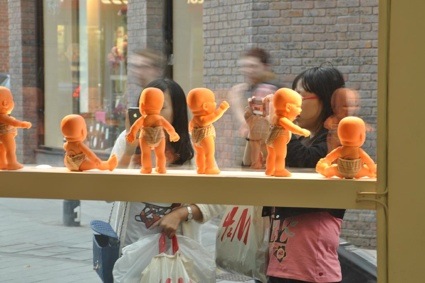 Mr Democracy
Mr Democracy
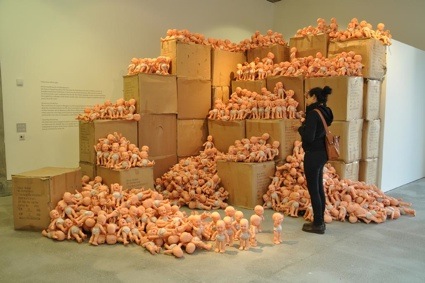 Mr Democracy
Mr Democracy
I’m also interested in your experience in finding, selecting and communicating with 3 factories in China which would manufacture the dolls. Is it easy for an individual to commission a thousand dolls to a Chinese factory? Did you require any help for that?
I had never done anything like this, and in some ways China was less accessible than I thought it would be. So many products are manufactured there, yet the process of getting something made isn’t easy. It involves lots of long meetings, misunderstandings, and sometimes deception. The doll itself was not commissioned for my project, but the sound chip and electronics were, and it was very unusual to have such a long sound recording – they are usually just 10 seconds, not over 10 minutes!
The British Council were helpful in finding people to help me, so I had an art student as a translator and fixer, though actually he had no more experience in finding a factory than me – he was an art historian. I also spoke a lot to a Chinese designer (Tom Shi) who had studied in the UK, and moved back to Guangzhou to start a design practice, and a family. He let me use his studio for free while I was in Guangzhou, and the two students (Sarah Yin Liu and Jackon Li Yao) helped me way beyond what any assistant should, and we’re still friends.
It was all very hands on. I was not doing this in the way most business people presumably do: I visited all the factories, filmed there, and organised the shipping myself -I even went into the ports, which was fascinating.
I think the main person I worked with at the factory that installed the sound chips into the dolls was mainly just interested in meeting me, and of course I wanted to meet him too. There was a funny moment when we were sending the sound file back and forth trying to compress it for the sound chip, and after I had actually agreed to going ahead with it, he called back to tell me that one of the articles was repeated on the sound chip. It was funny to have him read it back to me, as I had always been careful to not talk about the political content of the piece, but as long as it wasn’t about China, it wasn’t a problem. It was also funny to hear 1000s of dolls in a Chinese factory saying ‘The Constitution of the United Kingdom of Great Britain and Northern Ireland, Article One…’, as they were being tested.
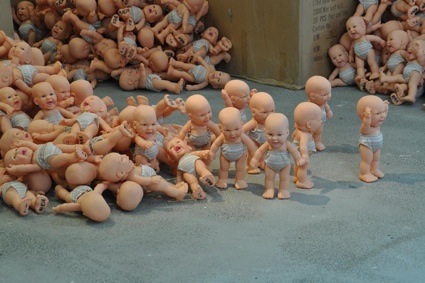 Oliver Walker, Mr Democracy
Oliver Walker, Mr Democracy
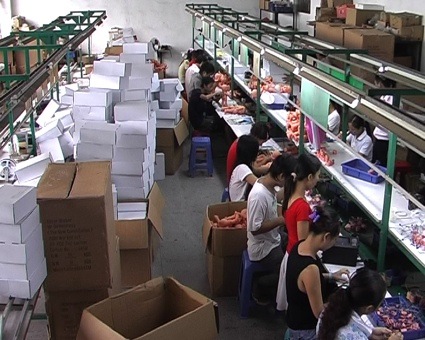 Oliver Walker, Mr Democracy. Democracy Production 3 (image via)
Oliver Walker, Mr Democracy. Democracy Production 3 (image via)
By the way, why did you chose China and not India? because i suspect that this choice made the working process even more challenging.
China does have a different position with regard to global development than India, but India might have seemed a more obvious choice, historically. China seems more unequivocally a coming super power than India, and is much more symbolic as a place where products are manufactured. Also, the vast majority of toys in the world are made in China, (and of those a large majority in the Pearl River Delta). That China is not considered a Democracy is also important.
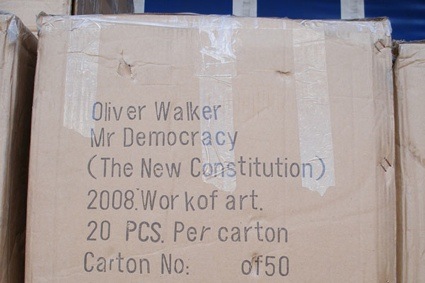 Oliver Walker, Mr Democracy
Oliver Walker, Mr Democracy
I was reading through the blog of the project and found this entry. Could you explain what happened here? How artworks are usually assessed at customs? What is the rule or law? And how it all ended?
When you export/import something, you use a customs agent to organise the customs for you. Mine refused to describe my dolls as artwork, because they were, well, dolls. Artworks attract a lower rate of VAT and no duty, so the difference is huge, as it’s a percentage of the value. As the project was funded by the Arts Council England and supported by the British Council, I thought I had a chance of getting them through as an artwork, which of course they are.
I had direct contact with a customs officer, and she explained that Haunch of Venison were currently in a legal battle with the authorities over the import of a complete video installation (with the video equipment), while the customs were insisting it was simply technical equipment. It was a Bill Viola piece. The customs woman conditionally agreed to view my works as artwork after I emailed her photos taken in the factory with me working on the piece, because their definition revolves around working on objects by hand, pretty much ignoring two generations of contemporary art. I was quite impressed with my negotiating skills!
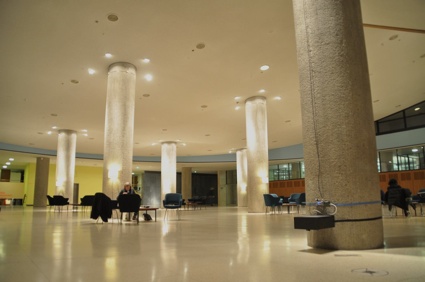 Oliver Walker, Bringing the Market Home
Oliver Walker, Bringing the Market Home
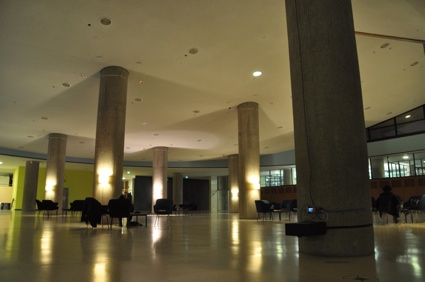 Oliver Walker, Bringing the Market Home
Oliver Walker, Bringing the Market Home
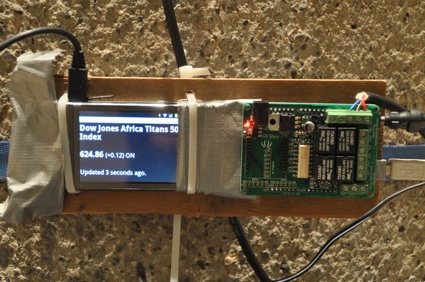 Oliver Walker, Bringing the Market Home
Oliver Walker, Bringing the Market Home
Now let’s have a look at another of your projects, Bringing the Market Home. Why did you chose to work with the Dow Jones Africa Titans 50 index? Why select a pan-African index for an installation that was located in Europe?
The piece reverses a tendential direction of influence, with an African share index determining the operation of an aspect of everyday life in a western city, in this case Berlin. Financial markets exercise massive influence, both directly and indirectly over many people’s lives over the globe, and this piece makes already existing connections physical, and immediate, while changing the direction of those influences. A blip of speculation on food prices could make a crop unaffordable for thousands of people in one country or region: in this piece, that process is reversed, making financial indicators from Africa (‘the 50 leading companies that are headquartered or generate the majority of their revenues in Africa’) tangible (cutting the house lighting of the HKW, House of World Cultures, Berlin) in a western city.
Was it on 24/7? Or does the Dow Jones follows 9-to-5 type working schedules?
Yes, it ran 24/7. The first time we got it working it was two in the morning, and we didn’t know if the index would be shifting, but it was! We spent ages trying to work out which indices would be working when, but in the end the stocks are traded on multiple exchanges across the world, so several of the indices can change for most of the day, although there are periods when no exchange is open.
So what was the impact that this connection with the DJAT50 had on the lighting circuit in a corridor? Was the light constantly on and off? Or were fluctuations slower to manifest themselves?
Essentially it’s pretty erratic. It is read every 30 seconds, and we didn’t analyse the data explicitly, but it changes fairly often – sometimes five times in a row, sometimes remaining off for five minutes. This worked well performatively – sometimes meaning viewers didn’t notice that there was any change to the system, and then suddenly asking themselves what was happening, why the lights weren’t working. This was an important consideration of the project (that you can’t see from the documentation) – I really wanted it to be something that was installed in the existing space, that people noticed and asked themselves why this was happening, rather than an autonomous object that people were invited to look at.
Any upcoming project, event, field of research you’d like to share with us?
I’d like to continue working on the One Pound project and Dinner Party. I’ve also been looking at the relationship between money and happiness, which I started looking at on residency in Paris at the Cité des Arts. I think inequality, mighty fascinating as it is, will come up again soon too, though I don’t know how at the moment.
Thanks Oliver!
You can see Oliver Walker’s video installation One Pound at the exhibition Time & Motion: Redefining Working Life, at FACT in Liverpool until Sunday 9 March 2014.
